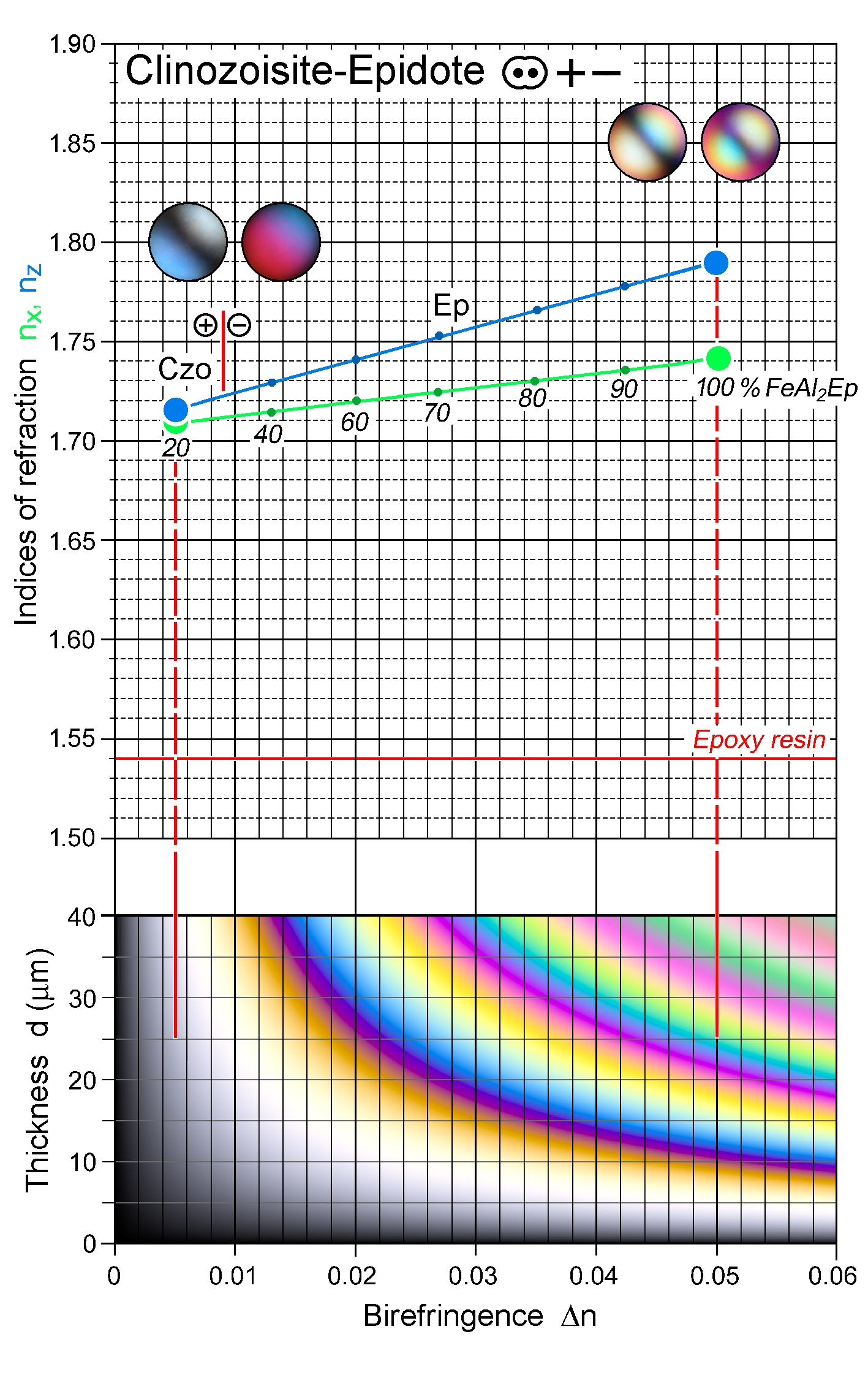|
| Formula | Ca2(Al,Fe3+)Al2O(Si2O7)(SiO4)OH |
| | Optic class & sign | Biaxial positive or negative |
| | Optical orientation | b = Y, a near Z and c near X |
| | Optical plane | (010) |
| | Relief | High |
| | Refractive indices | nx = 1.708 -1.735
|
|
ny = 1.710 -1.767
|
|
nz = 1.713 -1.785
|
|
| n increases with increasing Fe3+; regression curves change their slope at about 0.45 and 0.7 Fe3+ |
| | Birefringence (max.) | 0.005 - 0.050 |
| | | Δn increases with increasing Fe3+; chemical zoning is common and is most easily recognized by a variation in interference colour. Strong dispersion causes anomalous blue and brown colours in clinozoisite and brilliant colour tones in higher-birefringent members of the series |
| | Optic Angle
| 2Vx
= 70 - 90° |
| | 2Vz
= 90 - 60° |
| | Sign of elongation | Length-slow, l (+) and length-fast, l (-) for crystals elongate in b (= Y) |
| | Interference figure | Isogyres distinct to diffuse. Optic axis dispersion commonly strong. |
| | Colour / pleochroism | Colourless (clinozoisite) to pale yellow or greenish yellow (epidote), with pleochroism Y > Z > X; X = colourless, pale yellow, Y = yellow, greenish yellow, Z = colourless, pale greenish yellow. Distinct pleochroism is observed if epidote is Fe-rich. |
| | Zoning | Chemical zoning is common and most evident from interference colour variation. If Fe-rich epidote is present, distinct colour zoning is observed. Sector zoning may be present. |
|
|
| Form | Habit | Granular aggregates, columnar to acicular |
| | | Surface | Anhedral isolated grains and aggregates; subhedral to euhedral equant and prismatic crystals |
| | Cleavage | {001} perfect, also {100} |
| | Twinning | Simple and, less commonly, multiple twins on {100} |
| | Extinction | Straight to prism faces in elongate sections parallel b |
|
|
| Reaction textures | Retrograde product of Ca-feldspar breakdown and the breakdown of Fe-Mg silicates |
| | Alteration / decomposition | Relatively resistant in surface environments |
|
|
| Occurence | Ign | Rare as a primary magmatic mineral in mafic and granitic rocks |
| | | Met | Characteristic mineral in greenschist-facies mafic rocks; common in amphibolites, Ca-rich metapelites, quartzite, calc-schists, calcsilicate rocks, skarn and impure marble; also in reaction zones between carbonate and metapelitic rocks; rodingites |
| | | Sed | Locally as detrital grains |
| | | Hyd | Precipitate in fissures, veins and amygdales in a variety of igneous rocks; epidote-rich alteration patches and zones |
| | | Other | |
|
|
| Distinctive properties | High relief, birefringence; clinozoisite: anomalous first-order interference colours; epidote: characteristic bright second- to third-order interference colours. Distinctive zoning patterns resulting from the high sensitivity of Δn to compositional variation. |
| | Additional comments | The numerical optical data listed here are those of Hörmann & Raith (1971) for compositions from 0.2 to 1.0 Fe3+ pfu. Many older literature data have proven to be unreliable.
Originally, the compositional boundary between clinozoisite and epidote had been defined by the change of optic sign from positive (Czo) to negative (Ep). The IMA classification now defines the boundary at 50 mole% epidote endmember (0.5 Fe3+ pfu, equal to 16.7% Fe3+ occupation of the octahedral M positions).
|
|
|

 Images
Images 


 Images
Images 
